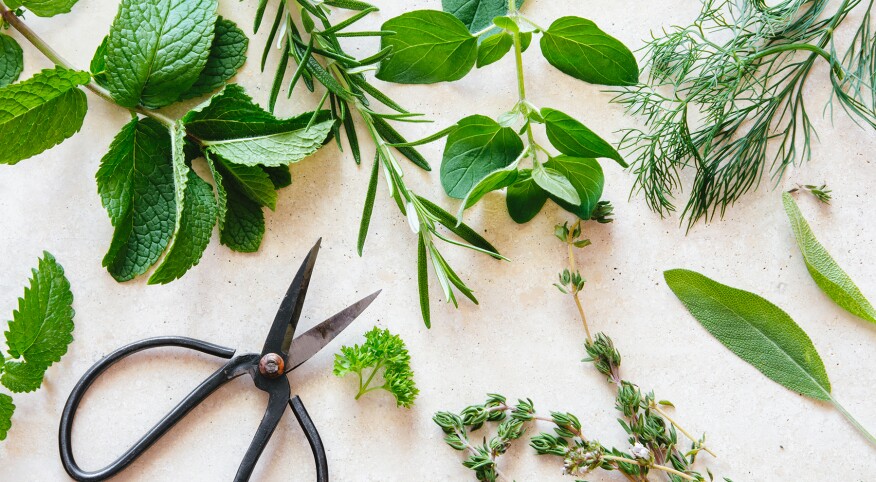Even if you aren’t cultivating a sourdough starter, chances are you’ve spent some time digging in the dirt over the past few months. As the coronavirus pandemic drags on, people across the U.S. are finding satisfaction (and stress relief) in tending bountiful gardens and growing their own food.
“Edible plants give us pleasure in so many ways — the way they look, the way they smell, the way they taste,” says Susan Belsinger, culinary herbalist and coauthor of Grow Your Own Herbs. “Every day you’re looking at a miracle happening, as it grows from a seed to a baby plant to a big plant that’s going to produce something you can eat. It’s both a comforting and rewarding hobby.”
Of course, not everyone has a big, sunny yard that can accommodate rows of crops — or even a yard at all. That’s why experts say the easiest “victory garden” you can grow during the pandemic is an herb garden, which can easily be sown in a postage-sized plot of land or in containers. Here are tips from the experts to make it happen.
Pick your plants
This late in the growing season, it’s best to start with small cuttings or propagated plants rather than seeds, says Tim Daly, a county extension agent with the University of Georgia who has tended his own herb garden for decades. “Depending on where you live, some plants that take longer to get established might not make it before the first frost sets in,” he says.
When choosing what to plant, consider what you like to eat, suggests Belsinger. “The herbs you enjoy cooking with are what you should grow, because you’ll use them,” she says. “And you’ll get inspired to do things like create your own salad dressings and herb pastes and all kinds of kitchen wealth.”
Pot wisely
To grow a tomato or a squash takes a really big pot, but herbs will generally thrive in small to medium containers, says Belsinger, who suggests starting with a smaller pot and moving to a larger size later on if necessary. Every now and then, pull your plant out of the pot and look at its roots. If it’s getting root-bound (in which the roots are densely wrapped around the soil or growing out of the drainage holes), step it up to a larger size. “At the same time, don’t stick a tiny 2-inch plant in a whiskey barrel,” she says. “You need to match the size of the plant to the container.”
Choose the right soil
You can combine herbs — or herbs and flowers — in the same pot, says Daly, as long as you have enough space and put “like with like” in terms of the plants’ needs. Generally, Mediterranean herbs (which include rosemary, sage, thyme, savory, oregano and lavender) prefer sandy, rocky soil and full sun, while annual herbs like basil, dill or coriander prefer more loamy, rich soil, and thrive in full sun to part shade. (Growing indoors and your window doesn’t receive hours of direct sun? Consider supplementing with artificial grow lights, suggests Daly.)
If you’re in a humid environment, adds Belsinger, “plant up, not deep in the pot, to increase air circulation around the plant. And sprinkle chicken grit on top of the soil. This is a white mulch that will reflect more light and heat on the plant and reduce mildew.”
Keep them healthy
The biggest mistake new gardeners make, agree Daly and Belsinger, is watering either too little or too much. Good drainage is important for herbs, particularly those from the Mediterranean region, and that means letting the soil get a little dry in between watering. (An easy trick: Stick your finger into the soil up to the first knuckle; if you feel moisture, don’t water again yet.)
Herbs also benefit from compost — a natural fertilizer — that has been worked into the soil. Belsinger likes to feed her herbs a botanical “tea,” which she brews by adding compost to a 5-gallon bucket, filling it with water and then straining it after a couple of days. “Even pasta water or water from the salad spinner is very nourishing, and it helps you reduce water waste,” she says.
Harvest frequently
The more you cut your plants, the more they’ll grow — and the bigger your harvest. “For annual herbs like basil, I cut them back to above the bottom two sets of leaves at least four times per season,” says Belsinger. “But doing that, I average 24 cups of basil leaves!” Perennial herbs (like thyme, oregano, mint and rosemary) should be cut back slightly less aggressively, although you can still reduce the plant’s size by up to half.

Stocksy









